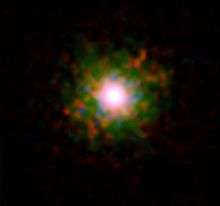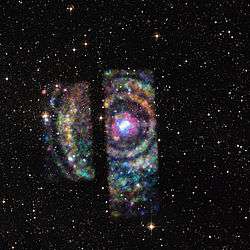Circinus X-1

Circinus X-1 is an X-ray binary star system that includes a neutron star. Observation of Circinus X-1 in July 2007 revealed the presence of X-ray jets normally found in black hole systems; it is the first of the sort to be discovered that displays this similarity to black holes. Circinus X-1 may be among the youngest X-ray binaries observed.
Location, distance
On June 14, 1969, an Aerobee 150 rocket, launched from Natal, Rio Grande do Norte, Brazil, obtained X-ray data during a scan of the Norma-Lupus-Circinus region that detected a well-isolated source at ℓ = 321.4±0.9° b = -0.5±2° (galactic), RA 15h 14m Dec −57° 49′ within the constellation Circinus and referred to as Circinus XR-1 (Cir XR-1).[1] The distance of Circinus X-1 was not well established, with a low estimate of 13,400 light years[2] and high estimate of 26,000 light years.[3]
On June 23, 2015, an article published on NASA's Chandra X-Ray Observatory's website, revealed that an international team of astronomers has succeeded in determining its distance from Earth with more precision - via a method of triangulation of X-ray light emitted by the star, echoing through stellar clouds and interstellar dust - as being about 30,700 light-years.[4]
X-ray source and age related to supernova remnant
A 16.6 day X-ray period was found by Kaluzienski et al.[5] The X-ray source is assumed to be a neutron star as part of a low-mass X-ray binary (LMXB), type-I X-ray burster.[6] The X-ray and radio nebulae surrounding Circinus X-1 have properties consistent with a young supernova remnant. This rare case of an X-ray binary apparently associated with a supernova remnant suggests the binary is very young on cosmic time scales, possibly less than 4600 years old.[7] An association of Circinus X-1 with a different nearby supernova remnant, G321.9-0.3, has been ruled out.[6]

Other spectral regions
The binary nature of Cir X-1 has been established.[8] The binary's radio component and a possible visual counterpart were identified by Whelan et al.[9] Its infrared counterpart was located and found to flare with a 16.6d period by Glass.[10] A (heavily reddened) precise optical counterpart (now known as BR Cir) was identified by Moneti.[11]
References
- ↑ Margon B; Lampton M; Bowyer S; Cruddace R (Oct 1971). "A Pulsing X-Ray Source in Circinus". Ap J. 169 (10): L23–5. Bibcode:1971ApJ...169L..23M. doi:10.1086/180806.
- ↑ R. Iaria; M. Spano; T. DiSalvo; N.R. Robba; et al. (January 2005). "On The Soft Excess In The X-Ray Spectrum Of Circinus X-1: Revisitation Of The Distance To Circinus X-1" (PDF). The Astrophysical Journal. 619 (1): 503–516. arXiv:astro-ph/0410259
 . Bibcode:2005ApJ...619..503I. doi:10.1086/426422. Retrieved 5 December 2013.
. Bibcode:2005ApJ...619..503I. doi:10.1086/426422. Retrieved 5 December 2013. - ↑ "Circinus X-1: Neutron Stars Join The Black Hole Jet Set". Harvard-Smithsonian Center for Astrophysics. Retrieved 5 December 2013.
- ↑ "NASA's Chandra Captures X-Ray Echoes Pinpointing Distant Neutron Star". Retrieved 2015-06-24.
- ↑ Kaluzienski, L. J.; Holt, S. S.; Boldt, E. A.; Serlemitsos, P. J. (1976). "Evidence for a 16.6 day period from Circinus X-1". Astrophysical Journal. 208: L71–L75. Bibcode:1976ApJ...208L..71K. doi:10.1086/182235.
- 1 2 Mignani RP; De Luca A; Caraveo PA; Mirabel IF (2002). "HST observations rule out the association between Cir X-1 and SNR G321.9-0.3". Astron Astrophys. 386 (2): 487–91. arXiv:astro-ph/0202268
 . Bibcode:2002A&A...386..487M. doi:10.1051/0004-6361:20020224.
. Bibcode:2002A&A...386..487M. doi:10.1051/0004-6361:20020224. - ↑ S. Heinz; P. Sell; R.P. Fender; P.G. Jonker; et al. (December 2013). "The Youngest Known X-ray Binary: Circinus X-1 and its Natal Supernova Remnant". The Astrophysical Journal. 779 (2): 171. arXiv:1312.0632
 . Bibcode:2013ApJ...779..171H. doi:10.1088/0004-637X/779/2/171.
. Bibcode:2013ApJ...779..171H. doi:10.1088/0004-637X/779/2/171. - ↑ Jones C; Tananbaum H; Giacconi R (1973). "UHURU Observations of the Binary Nature of Circinus X-1". 141st Meeting Amer Astron Soc. Tucson, Arizona. Bibcode:1973BAAS....5..395J.
- ↑ Whelan, J. A. J.; Mayo, S. K.; Wickramasinghe, D. T.; Murdin, P. G.; et al. (1977). "The optical and radio counterpart of Circinus X-1 /3U 1516-56/". Monthly Notices of the Royal Astronomical Society. 181: 259–271. Bibcode:1977MNRAS.181..259W. doi:10.1093/mnras/181.2.259.
- ↑ Glass, I.S. (1978). "Variations of Circinus X-1 in the infrared". Monthly Notices of the Royal Astronomical Society. 183: 335–340. Bibcode:1978MNRAS.183..335G. doi:10.1093/mnras/183.3.335.
- ↑ Moneti, A. (1992). "Optical and infrared observations of Circinus X-1". Astronomy and Astrophysics. 260: L7–L10. Bibcode:1992A&A...260L...7M.
- "Circinus X-1: Neutron Stars Join the Black Hole Set". Chandra X-Ray Observatory. Harvard University / National Aeronautics and Space Administration. 2007. Retrieved 8 January 2009.